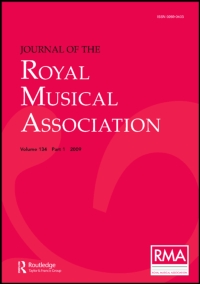Article contents
On Medical Science in Relation to the Voice as a Musical Instrument
Published online by Cambridge University Press: 01 January 2020
Extract
The subject which I have chosen for the consideration of the Musical Association presents to the most casual observer so many obstacles in the way of treatment that it will be easily believed I approach my task with feelings of diffidence. The largeness of the field for discussion, the difficulty of treating the musical or, to me, unfamiliar portion in a manner worthy of this Association, and the fear lest the medical portion may be tediously or too technically dwelt upon, have tended to render me distrustful of success. Were I not well assured of the generous forbearance shown by professional men to those who have real desire to contribute to our common knowledge, I had many times turned back from the plough to which I have put my hand.
- Type
- Research Article
- Information
- Copyright
- Copyright © Royal Musical Association, 1875
References
∗ The direction of Signor Garcia for a singer to practise his voice with a lighted candle before the month is known to many. If the flame is extinguished, or even wavers, it is a sign that too much air is being expended.Google Scholar
† ‘Quand on respire pour parler ou pour renouveler simplement l'air des poumons, le premier mouvement est celui de l'aspiration, alors le ventre se gonfle et sa partie postérieure s'avance un peu…… An contraire, dans l'action de respirer pour chanter, en aspirant il faut aplatir le ventre et le faire remonter avec promptitude, en gonflant et avançant la poitrine.’—Méthode de Chant du Conservatoire de Musique.Google Scholar
‡ I cannot forbear mentioning that I have received a most interesting communication from a lady in Amsterdam, who, having read a translation of the brief abstract of my paper which appeared in the daily press, recounts how sad were the results to her voice of the teaching in a certain Conservatoire on the Continent; how that four years of rest and medical treatment did nothing for her, but how that Mons. Wartel, the able instructor of Mesdames Nilsson and Trebelli, at once recognised the cause of her loss of voice, and placed her in the way of regaining it ‘in three months as strong as it ever was before.’ This lady very sensibly suggests that ‘a kind of diaphragmatic gymnastique would not only enlarge the respiratory organs, as does singing with good breath-taking, but that it would thus cause women who are not singers to make more healthy blood, and to gain more strength in general.’Google Scholar
∗ I do not forget in making this statement that Signor Garcia, in his masterly communication to the Royal Society (Society's Proceedings, Vol. vii. No. 13, 1855), came to the conclusion that ‘the remarkable arrangement of the fibres (of the intrinsic muscles of the larynx—i.e. those acting on the vocal cords themselves) enables us to explain the elevation of the voice’; nor do I for a moment venture to dispute his facts; but I think that he and all other teachers since him, following in his wake, attempt to prove more than can be proved from the action of the vocal cords alone. He admits that the traches may modify the force of the air from the lungs, and that the pharynx modifies the quality of the voice. My suggestion is that pitch and quality are both modified by these causes.Google Scholar
∗ See the interesting paper of Professor Grylls Adams in the present volume, pp. 84 et seq.Google Scholar
∗ This subject is referred to by the Rev. Sir Gore Ouseley in his communication in the present volume, page 31.Google Scholar
∗ I have had analyses made of, I think, every variety of patent voice lozenges. There is not one that does not contain more or less Cayenne pepper or some like irritant, and that is not consequently harmful. I take this opportunity of disavowing any connection with some lozenges bearing the same name as my own. However useful they may be as ‘bronchial troches,’ they are totally unsuited for voice lozenges.Google Scholar
∗ It is impossible to say how much mischief has been done by the absurd accounts of the variety of beverages indispensable to our former great singers. Whatever may have been the practice in the past, such notions as that the drinking of so many bottles of beer or stout per evening will give voice are as obsolete as, I am happy to say, is the idea that no man is a hospitable gentleman who allows his guests to go home sober. I am glad to quote here Mr. Sims Beeves' observations on this point in a letter already referred to:— ‘I was much interested in the remarks made by you at the meeting of the Musical Association with regard to the use of stimulants. By long experience I find it much better to do without them entirely. A glycerine lozenge is preferable; on very rare occasions a small quantity of claret and water may be necessary, but all alcoholic stimulants are detrimental. I formerly, and for many years, used beef tea, but that was too heavy. If one could limit oneself to a table-spoonful at a time, the latter might be the best; but a large draught clogs the throat, and produces more saliva than is necessary, and induces the desire to swallow often.’Google Scholar
∗ I regret to say that I have seen not a few instances of good baritone and mezzo-soprano voices utterly ruined by the endeavours of masters to convert them into tenors and soprani.Google Scholar
- 2
- Cited by


